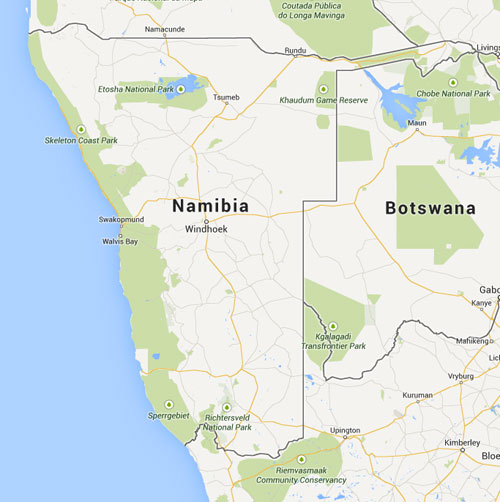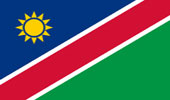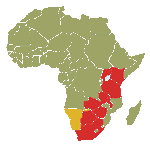Destination Namibia
In a Nutshell
Not purely a safari destination but clean, safe, easy to navigate around on a self-drive trip and with some of the most dramatic and open landscapes in Africa. Sparsely poulated and hauntingly remote, it is not the best for game viewing which is primarily centred on Etosha, but is up and coming due to its wilderness, accessibility and security. It offers an intriguing point of difference for previous visitors to Africa.
Climate
Jan |
Feb |
Mar |
Apr |
May |
Jun |
Jul |
Aug |
Sep |
Oct |
Nov |
Dec |
||||||||||||
c |
mm |
c |
mm |
c |
mm |
c |
mm |
c |
mm |
c |
mm |
c |
mm |
c |
mm |
c |
mm |
c |
mm |
c |
mm |
c |
mm |
30 |
76 |
29 |
76 |
27 |
77 |
26 |
35 |
22 |
20 |
20 |
3 |
20 |
0 |
23 |
0 |
26 |
3 |
29 |
10 |
29 |
23 |
31 |
32 |
(average high temp in degrees c and average rainfall in mm) for Windhoek
 Facts
Facts
Size: 824,268 Sq Km
Population: 2m
Capital: Windhoek
Flying Time: Windhoek 12 hours
People: Mainly Ovambo (50%) also Kavango, Herero, Damara, European and others
Languages: English (Official) but German and Afrikaans are spoken widely
Major Industries: cattle ranching, fishing, agriculture, mineral products and tourism
Currency: Namibian Dollar (N$)
Visa: Not required for UK passport holders
Time: GMT +2 Summer/ +1 Winter
Budget: From £1900 self-drive to £2800 for 2 weeks
Background
Namibia is situated along the Atlantic seaboard on the south west coast of Africa and borders South Africa, Angola, Botswana, Zambia and Zimbabwe (via the Caprivi Strip). It is dominated by its rugged landscape and is vast even by African standards yet has one of the lowest population densities in the world. Namibia has a generally harsh climate, though with considerable variation across the country. The central Namib desert is sunny year round, the east and south is arid semi-desert, while the seaboard is much cooler with frequent mists.
Namibia is 4 times bigger than the UK and 27 times bigger than Belgium.
The 17 National Parks and Reserves make up 15% of the country.
| Principal Parks and Reserves | ||
| • Etosha NP | • Waterberg Plateau Park | |
| • Namib Naukluft Park | • Kaudom GR | |
| • Skeleton Coast Park |
Highlights
Largest sand dunes in the world at Sossusvlei
Vast and isolated Skeleton Coast - a treasure trove of dunes, seal colonies and shipwrecks
Etosha National Park - has one of the world's densest animal populations
Fish River Canyon - the world's second biggest after the Grand Canyon in the US
Damaraland's huge Haub River Valley
The remote and desolate Namib desert
Visiting the nomadic Himba and Herero people
Ancient Brandberg and Twylfontein bushmen rock art
| Activities | ||
| • Game drives and walks | • Boat trips to view seals, penguins & dolphins | |
| • Hiking and trekking | • Sea Fishing | |
| • Ballooning | • Horseback safaris | |
| • Quad biking | • Skydiving | |
| • Sandboarding/Duneboarding | • Canoeing and Sea Kayaking | |
| • Parasailing | ||
| Best for | ||
| • Stunning, unspoilt landscapes and rugged • wilderness with unusual geological features |
• Seals, desert elephant and cheetah (highest • volume in Africa) |
|
| • Self-drive and family group trips | • Dune adventure activities | |
When to go: All year but best during the dry winter May-Oct |
||
| • Nov-Jun = low season | • Jul-Sep = peak season | |
| • Oct-Apr = summer | • May-Sep = winter | |
| • Nov-Mar = rains | • Jan-Mar = wettest, Jul-Aug = driest | |
| • Nov-Jan = hottest | • Jul-Sep = best game-viewing | |
| • Dec-Mar = best birding | • Dec-May = best flowers | |
| Back to destinations |




